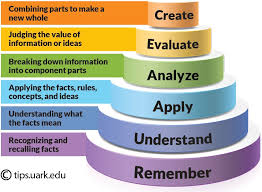Ambitious legal lecturers use insight in learning processes to help them increase the impact of their teaching efforts. An helpful framework to provide such insight was developed back in 1956 by Benjamin Bloom.
Bloom’s model helps lecturers to focus their teaching towards what is needed by the learner. And, equally important, it helps lecturers prioritising: enabling legal learners to think critically, solve legal problems etc. requires other learning to take place first.
Bloom distinguished different levels of learning. These levels can be thought of as degrees of difficulty. The lower levels must normally be mastered before learning on the next level can occur. Each level represents a cognitive process that requires its own teaching approach.
In exercising their profession legal specialists are often expected to operate within the top-3 levels (analysing, evaluating, creating) of the above pyramid. Lecturers should note however, that prior to being able to operate on these levels, the lower first three levels (remembering, understanding and applying) need to have been addressed by the lecturer or acquired by the learners.
To teach effectively, lecturers need therefore to be constantly aware of the question:what is prerequisite to my teaching and do my learners really posess these prerequisites?
Refinement of Bloom: different knowledge categories
Bloom’s model was further refined by distinguishing different categories of knowledge that can result from teaching:
- Factual knowledge – The basic elements students must know to solve problems(example: what is a permanent establishment?)
- Conceptual knowledge -The interrelationships among the basic elements that enable them to function together (example: what is the role of a permanent establishment within the context of taxing company profits?)
- Procedural knowledge – How to do something (example: how to calculate taxable profits attributed to a permanent establishment?)
- Metacognitive knowledge – Awareness of one’s own cognition (example: do I understand why the concept of a permanent establishment has been developed and can I apply it succefully in a variety of concrete situations at my work?).
These different kinds of knowledge are the outcome of different cognitve procesess the learner passes through. Such processes are illustrated in the colored blocks in this table by Rex Heer, 2012:
Given a specific learning objective, lecturers can make their teaching more effective by limiting themselves to using those teaching techniques that target the needed kinds of knowledge.
For example one wants learners to “remember” a legal procedure; teaching techniques should then be used that create the ability to “recall” the procedure. (Example: calculate taxable profits: lecture and recall the different steps for taxable profit calculation). On the other hand, if the lecturer wants learners to be able to “apply” that legal procedure, instructional techniques should be aimed at enabling learners to “carry out” the procedure (example: provide profit figures and company’s respective operational countries to have learners calculate the correct taxable profits).
From abstract to concrete: Learning by doing
All this may sound rather abstract. Especially because in practice lecturers need to move flexibly up and down the pyramid to have legal learners simply perform better on their job.
Therefore, the down-to-earth advise is that lecturers should be equiped with a toolbox of teaching techniques. They should learn how to flexibly handle these tools: be acutely aware when and how to use each of these teaching techniques, what are the strong/weak points etc. when addressing legal performance problems of their learners.
In our workshops legal lecturers master teaching by getting thorough hands-on experience using such teaching techniques: They teach and improve themselves using feedback from peers and instructional experts until they have shown themselves capable of (1) using each of the required teaching techniques, (2) distinghuising situations using the appropirate technique and (3) knowing when to “shift gears”.
Often we extend our support by observing the lecturers perform “live” in their classes. Here we coach them to even higher levels of teaching performance. This proves to be powerful in raising self-confidence as well as achieving effective, efficient and engaging teaching.



